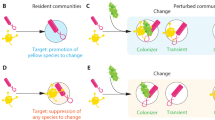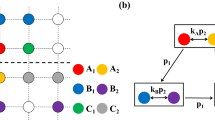Abstract
One of the central aims of ecology is to identify mechanisms that maintain biodiversity1,2. Numerous theoretical models have shown that competing species can coexist if ecological processes such as dispersal, movement, and interaction occur over small spatial scales1,2,3,4,5,6,7,8,9,10. In particular, this may be the case for non-transitive communities, that is, those without strict competitive hierarchies3,6,8,11. The classic non-transitive system involves a community of three competing species satisfying a relationship similar to the children's game rock–paper–scissors, where rock crushes scissors, scissors cuts paper, and paper covers rock. Such relationships have been demonstrated in several natural systems12,13,14. Some models predict that local interaction and dispersal are sufficient to ensure coexistence of all three species in such a community, whereas diversity is lost when ecological processes occur over larger scales6,8. Here, we test these predictions empirically using a non-transitive model community containing three populations of Escherichia coli. We find that diversity is rapidly lost in our experimental community when dispersal and interaction occur over relatively large spatial scales, whereas all populations coexist when ecological processes are localized.
This is a preview of subscription content, access via your institution
Access options
Subscribe to this journal
Receive 51 print issues and online access
$199.00 per year
only $3.90 per issue
Buy this article
- Purchase on Springer Link
- Instant access to full article PDF
Prices may be subject to local taxes which are calculated during checkout



Similar content being viewed by others
References
Chesson, P. Mechanisms of maintenance of species diversity. Annu. Rev. Ecol. Syst. 31, 343–366 (2000)
Tilman, D. & Pacala, S. in Species Diversity in Ecological Communities (eds Ricklefs, R. E. & Schluter, D.) 13–25 (Univ. Chicago Press, Chicago, 1993)
Czárán, T. L., Hoekstra, R. F. & Pagie, L. Chemical warfare between microbes promotes biodiversity. Proc. Natl Acad. Sci. USA 99, 786–790 (2002)
Dieckmann, U., Law, R. & Metz, J. A. J. (eds) The Geometry of Ecological Interactions: Simplifying Spatial Complexity (Cambridge Univ. Press, Cambridge, 2000)
Durrett, R. & Levin, S. The importance of being discrete (and spatial). Theor. Pop. Biol. 46, 363–394 (1994)
Durrett, R. & Levin, S. Allelopathy in spatially distributed populations. J. Theor. Biol. 185, 165–171 (1997)
Hassell, M. P., Comins, H. N. & May, R. M. Species coexistence and self-organizing spatial dynamics. Nature 370, 290–292 (1994)
Pagie, L. & Hogeweg, P. Colicin diversity: A result of eco-evolutionary dynamics. J. Theor. Biol. 196, 251–261 (1999)
Tilman, D. & Kareiva, P. (eds) Spatial Ecology: The Role of Space in Population Dynamics and Interspecific Interactions (Princeton Univ. Press, Princeton, 1997)
Rohani, P., Lewis, T. J., Grunbaum, D. & Ruxton, G. D. Spatial self-organization in ecology: pretty patterns or robust reality? Trends Ecol. Evol. 12, 70–74 (1997)
Frean, M. & Abraham, E. R. Rock-scissors-paper and the survival of the weakest. Proc. R. Soc. Biol. Sci. B 268, 1323–1327 (2001)
Sinervo, B. & Lively, C. M. The rock-paper-scissors game and the evolution of alternative male strategies. Nature 380, 240–243 (1996)
Buss, L. W. & Jackson, J. B. C. Competitive networks: Nontransitive competitive relationships in cryptic coral reef environments. Am. Nat. 113, 223–234 (1979)
Paquin, C. E. & Adams, J. Relative fitness can decrease in evolving asexual populations of S. cerevisiae. Nature 306, 368–371 (1983)
Bohannan, B. J. M. & Lenski, R. E. Linking genetic change to community evolution: Insights from studies of bacteria and bacteriophage. Ecol. Lett. 3, 362–377 (2000)
Korona, R., Nakatsu, C. H., Forney, L. J. & Lenski, R. E. Evidence for multiple adaptive peaks from populations of bacteria evolving in a structured habitat. Proc. Natl Acad. Sci. USA 91, 9037–9041 (1994)
Rainey, P. B. & Travisano, M. Adaptive radiation in a heterogeneous environment. Nature 394, 69–72 (1998)
Frank, S. A. Spatial polymorphism of bacteriocins and other allelopathic traits. Evol. Ecol. 8, 369–386 (1994)
Iwasa, Y., Nakamaru, M. & Levin, S. A. Allelopathy of bacteria in a lattice population: Competition between colicin-sensitive and colicin-producing strains. Evol. Ecol. 12, 785–802 (1998)
Nakamaru, M. & Iwasa, Y. Competition by allelopathy proceeds in traveling waves: Colicin-immune strain aids colicin-sensitive strain. Theor. Pop. Biol. 57, 131–144 (2000)
Adams, J., Kinney, T., Thompson, S., Rubin, L. & Helling, R. B. Frequency-dependent selection for plasmid-containing cells of Escherichia coli. Genetics 91, 627–637 (1979)
Chao, L. & Levin, B. R. Structured habitats and the evolution of anticompetitor toxins in bacteria. Proc. Natl Acad. Sci. USA 78, 6324–6328 (1981)
Feldgarden, M. & Riley, M. A. High levels of colicin resistance in Escherichia coli. Evolution 52, 1270–1276 (1998)
Feldgarden, M. & Riley, M. A. The phenotypic and fitness effects of colicin resistance in Escherichia coli K-12. Evolution 53, 1019–1027 (1999)
Gordon, D. M. & Riley, M. A. A theoretical and empirical investigation of the invasion dynamics of colicinogeny. Microbiology 145, 655–661 (1999)
James, R., Kleanthous, C. & Moore, G. R. The biology of E colicins: Paradigms and paradoxes. Microbiology 142, 1569–1580 (1996)
Riley, M. A. & Gordon, D. M. The ecological role of bacteriocins in bacterial competition. Trends Microbiol. 7, 129–133 (1999)
Huisman, J. & Weissing, F. J. Biodiversity of plankton by species oscillations and chaos. Nature 402, 407–410 (1999)
Huisman, J., Johansson, A. M., Folmer, E. O. & Weissing, F. J. Towards a solution of the plankton paradox: The importance of physiology and life history. Ecol. Lett. 4, 408–411 (2001)
Rice, E. L. Allelopathy (Academic Press, Orlando, 1984)
Acknowledgements
We thank M. Munos for help in the laboratory, N.B. Raju for helping with the plate photography, and D. Ackerly, P. Armsworth, C. Boggs, C. Devine, P. Godfrey-Smith, D. Gordon, A. Hirsh, J. Huisman, C. Jessup, S. Levin, D. Petrov, P. Rainey, T. Ricketts, S. Tuljapurkar, K. Walag and V. Walbot for many comments on previous versions of the manuscript.
Author information
Authors and Affiliations
Corresponding author
Ethics declarations
Competing interests
The authors declare that they have no competing financial interests.
Rights and permissions
About this article
Cite this article
Kerr, B., Riley, M., Feldman, M. et al. Local dispersal promotes biodiversity in a real-life game of rock–paper–scissors. Nature 418, 171–174 (2002). https://doi.org/10.1038/nature00823
Received:
Accepted:
Issue Date:
DOI: https://doi.org/10.1038/nature00823
This article is cited by
-
Circular and L50-like leaderless enterocins share a common ABC-transporter immunity gene
BMC Genomics (2023)
-
Metagenome-mining indicates an association between bacteriocin presence and strain diversity in the infant gut
BMC Genomics (2023)
-
Transitivity and intransitivity in soil bacterial networks
The ISME Journal (2023)
-
Bacterial defences: mechanisms, evolution and antimicrobial resistance
Nature Reviews Microbiology (2023)
-
Community composition and the environment modulate the population dynamics of type VI secretion in human gut bacteria
Nature Ecology & Evolution (2023)
Comments
By submitting a comment you agree to abide by our Terms and Community Guidelines. If you find something abusive or that does not comply with our terms or guidelines please flag it as inappropriate.



